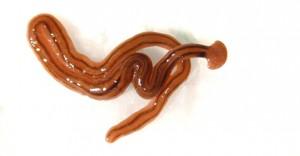Scientific classification of the Flatworm (Platyhelminthes):
- Domain: Eukaryotic (Eukaryotic)
- Country: Extinct (Fossil)
- Section of Country: Genuine Seat (Eumetazoa)
- Section of Courses: Ventricle (Coelomata)
- Group of Phylum: Ancient Foots (Ptorostomia)
- Superphylum: Platyzoa (Platyzoa)
- Phylum: Flatworms (Platyhelminthes)
Classes:
- Cestoda
- Monogenea
- Trematoda
- Turbellaria
General characterisation:
- Body flattened dorsoventrally
- Gaseous exchange by diffusion
- Nerve net with longitudinal nerve fibres with transverse connections
- Most are hermaphrodite
- They are aquatic, terrestrial and parasitic
- Bilaterally symmetrical
- Soft-bodied and worm-like
Structure:
Platyhelminthes are bilaterally symmetrical animals, in other words their left and right sides are mirror images of each other; this also implies that they have distinct top and bottom surfaces and distinct head and tail ends. Like other bilaterians they have three main cell layers, while the radially symmetrical cnidarians and ctenophores "(comb jellies)" have only two cell layers. Beyond that, they are "defined more by what they do not have than by any particular series of bodily specializations."Unlike other bilaterians, platyhelminthes have no internal body cavity and are therefore described as acoelomates. They also lack specialized circulatory and respiratory organs. Their bodies are soft and unsegmented.
Diet
Most platyhelminths have no anus and regurgitate undigested material through the mouth. However, some long species have an anus and some with complex branched guts have more than one anus, since excretion only through the mouth would be difficult for them.The gut is lined with a single layer of endodermal cells which absorb and digest food. Some species break up and soften food first by secreting enzymes in the gut or pharynx (throat).Cestodes have no mouths or guts, and the syncitial skin absorbs nutrients – mainly carbohydrates and amino acids – from the host, and also disguises it chemically to avoid attacks by the host's immune system. Shortage of carbohydrates in the host's diet stunts the growth of the parasites and kills some. Their metabolisms generally use simple but inefficient chemical processes, and the parasites compensate by consuming large amounts of food relative to their size.
Reproduction
The space between the skin and gut is filled with mesenchyme, a connective tissue that is made of cells and reinforced by collagen fibers that act as a type of skeleton, providing attachment points for muscles. The mesenchyme contains all the internal organs and allows the passage of oxygen, nutrients and waste products. It consists of two main types of cell: fixed cells, some of which have fluid-filled vacuoles; and stem cells, which can transform into any other type of cell, and are used in regenerating tissues after injury or asexual reproduction.
Land planarians
Michael Merchant, Ph.D., Professor and Extension Urban Entomologist, Texas AgriLife Extension Service
and
Mary Wicksten, Ph.D. , Professor, Department of Biology, Texas A&M University
Land planarians are similar in size to earthworms, but flattened with a spade-shaped head.
Land planarians are similar in size to earthworms, but flattened with a spade-shaped head.
Land planarians are one of the more unusual and interesting creatures in and around greenhouses and gardens. One of the most common Texas species is Bipalium kewense. This animal belongs to one of the most primitive animal groups, the Phylum Platyhelminthes–also known as flatworms. Originally from southeast Asia, this species has been dispersed by man to more than 50 countries around the world.
Bipalium kewense is recognized by its flattened head and longitudinal stripes. It is also one of the largest flatworms, reaching lengths of up to 25 cm (10 inches). It is a slimy animal, well endowed with mucus glands in its skin. It is even capable of hanging from leaves or branches by a string of mucus. Terrestrial flatworms are predators, and locate their prey through a process called chemo-sensation. Eggs are laid in capsules, and hatch as small worms.
Like flatworms of biology textbook fame, land planarians can also reproduce by dividing into fragments. They are not harmful to people and make interesting subjects for science fair projects on chemical smell and regeneration. In areas where they have become established, they can be collected on the surface of moist soil, or are sometimes seen on sidewalks after a rain.
Most terrestrial (non-aquatic) planarians in North America are exotic, having arrived here via the trade in potted foliage plants. Although land planarians do not attack plants, they are predators of earthworms, a fact that has raised concerns among some biologists. Unfortunately, little is known about their distribution, ecology, or true impact on earthworms in Texas.
No control for flatworms is available or recommended at this time. Avoid transferring infested potting soil or garden soil to uninfested sites. Suspected potting soil should first be heat sterilized before being used or transported.
For more information about terrestrial flatworms see the book, Living Invertebrates, by V. Pearse, J. Pearse, M. Buchsbaum and R. Buchsbaum, 1987, Blackwell Scientific Publications.
http://hu.wikipedia.org/wiki/Laposf%C3%A9rgek
http://sdt.sulinet.hu/Player/Default.aspx?g=351c8b9d-d15f-45ef-ba0f-f7fe4fa64784&cid=093b270f-4c13-418b-8496-4352ec68066f
http://citybugs.tamu.edu/factsheets/landscape/others/ent-1004/
